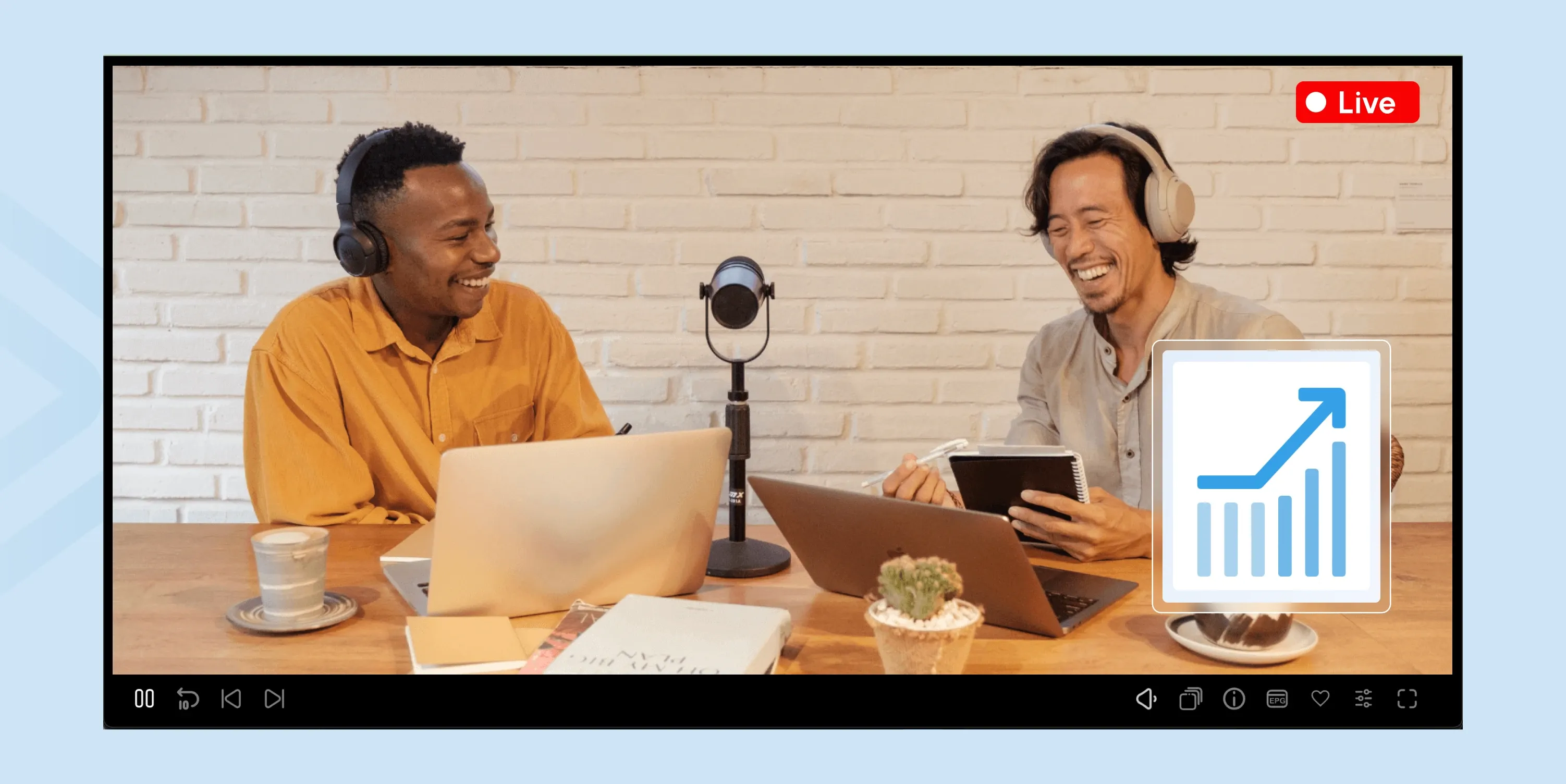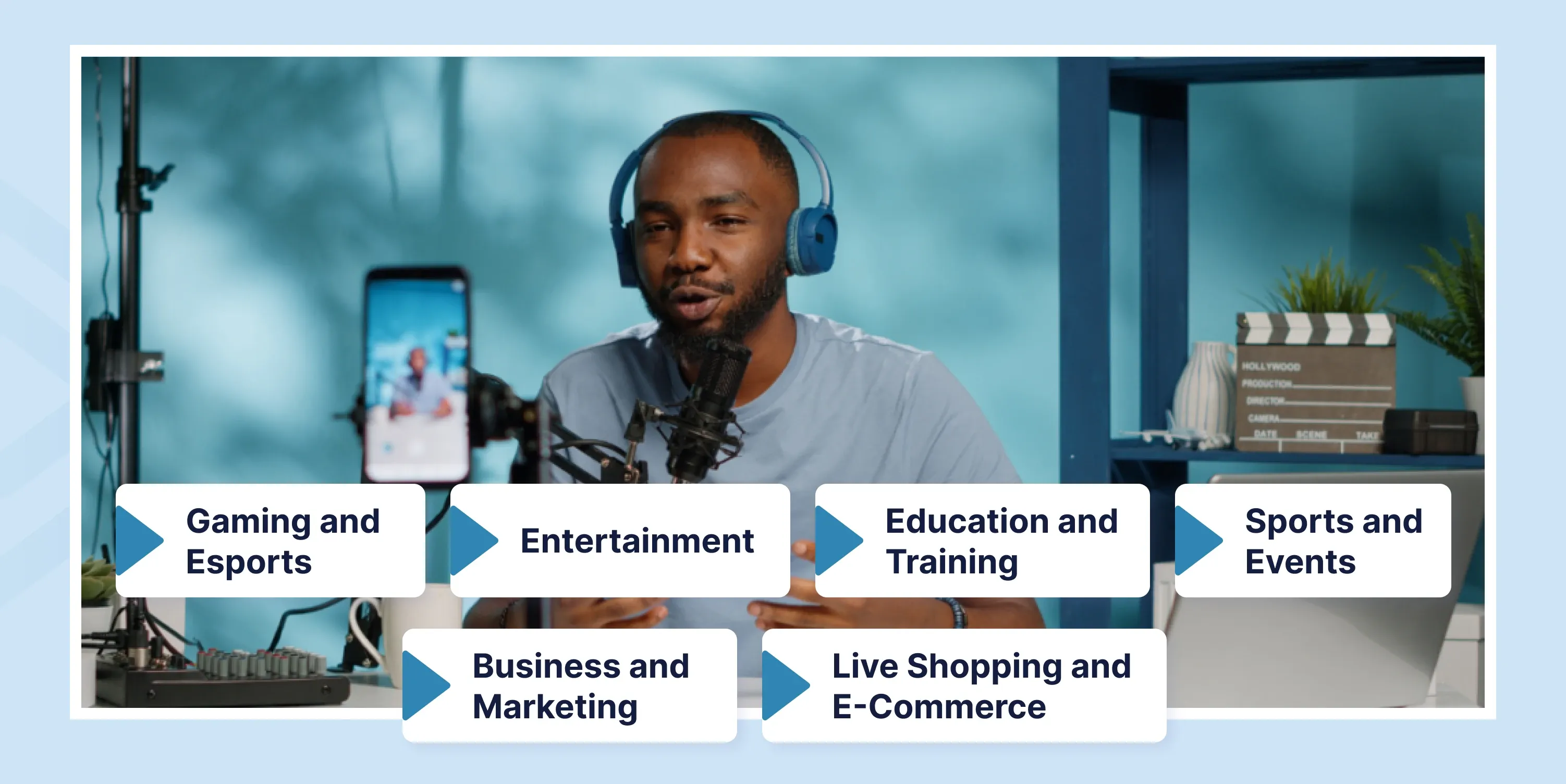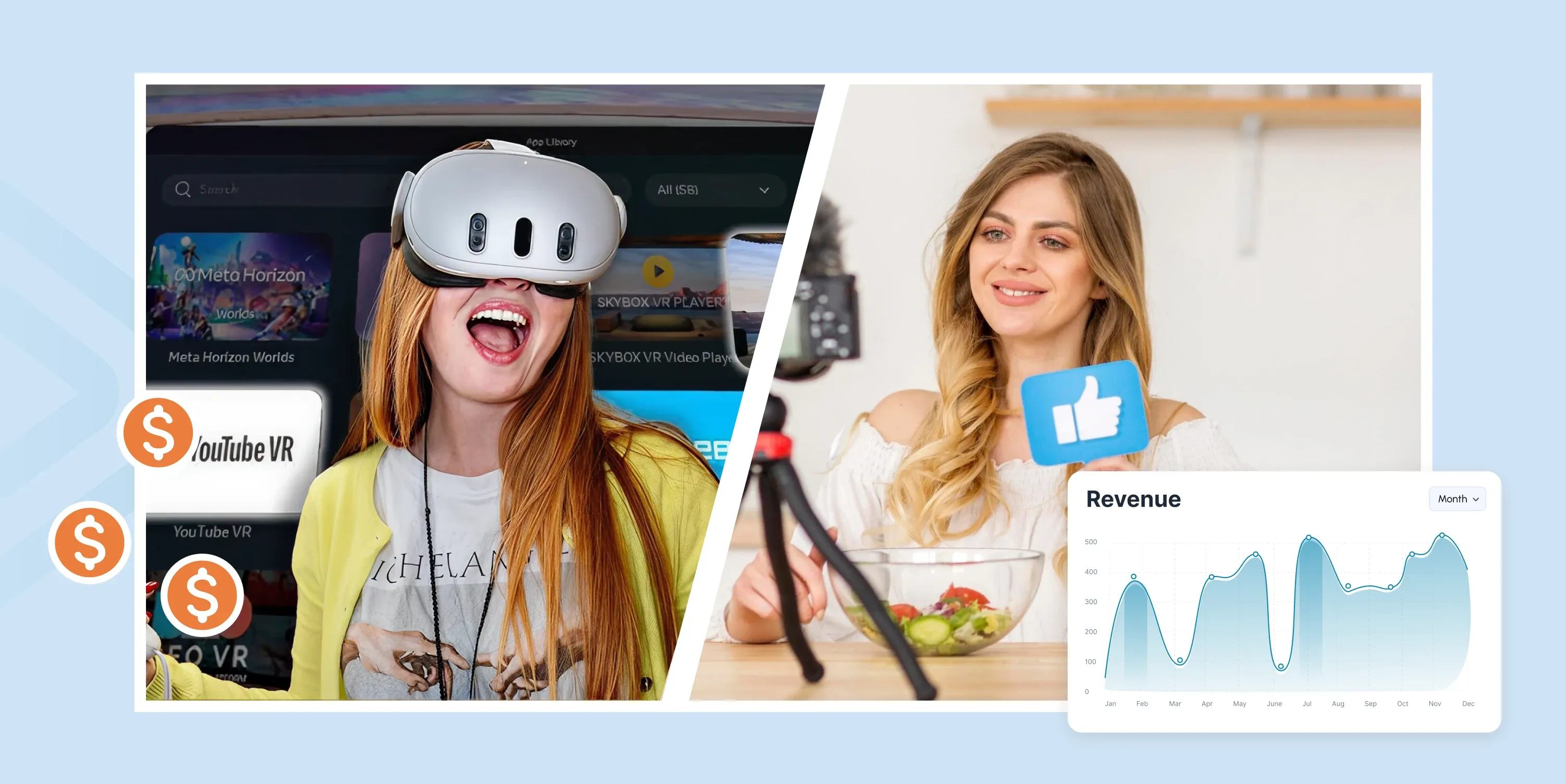
The Live Streaming Market: Trends and Opportunities
The live streaming market has changed how we consume and share content, fostering real-time connections between content creators and audiences.
Whether you're looking to get paid for live streaming or understand the live streaming market share, we’ll break down everything you need to know.
Let’s explore live streaming trends, the most effective monetization strategies, and the industry's key challenges.

Key Takeaways
- The live streaming market’s key segments are gaming, entertainment, and education.
- The most popular live-streaming platforms are YouTube, Twitch, Facebook, Instagram, and TikTok.
- The main monetization models for live streaming are ad revenue, subscription-based models, donations, crowdfunding, PPV, sponsorship, and affiliate marketing.
- Some common challenges in the live streaming industry include bandwidth and latency issues, low-quality content, content moderation, and privacy concerns.
Current State of the Live Streaming Market
Live streaming has completely changed how we connect, entertain, and do business online. With platforms like YouTube Live, Twitch, and Instagram, creators can go live anytime, anywhere, and interact with their audience in real time.
The live streaming market has exploded in recent years. In 2024, the global live streaming industry was valued at around $87.8 billion and is expected to skyrocket to $605.2 billion by 2033, growing at a 23.93% annual rate.
With faster internet, better smartphones, and more interactive features like live chats, polls, and shopping links, live streaming is more engaging than ever.
Live streaming is no longer just for gamers and influencers. Musicians, event planners, brands, and even educators are using it to reach wider audiences, blending in-person and online experiences. And this is because live streaming has become the best way to reach bigger audiences.
Key Market Segments and Platforms
 Several key segments and platforms are aiming to attract different types of audiences in the live streaming market. These include:
Several key segments and platforms are aiming to attract different types of audiences in the live streaming market. These include:
Gaming and Esports: Gaming remains one of the most popular live streaming content types on platforms like YouTube, Twitch, and Facebook. By live streaming your gaming experience, you can attract millions of viewers and gain opportunities for sponsorships, advertisements, and community engagement.
Entertainment: Musicians, comedians, and influencers use live streaming to connect with audiences, share performances, and host interactive Q&A sessions. Top platforms include Instagram Live, TikTok Live, Facebook Live, and YouTube Live.
Education and Training: Webinars, live tutorials, and workshops are in high demand now. With specialized platforms like MasterClass and Skillshare, online education is reaching a new level.
Sports and Events: Live sports broadcasting and major events like concerts and award shows drive massive engagement. Popular platforms include ESPN+, DAZN, YouTube Live, and Facebook Live.
Business and Marketing: Brands and businesses use live streaming for product launches, webinars, and virtual conferences to engage their audiences in real time. Top platforms include LinkedIn Live, YouTube Live, Zoom, and Webex. Many future-forward brands also have their own custom live streaming platform.
Live Shopping and E-Commerce: Retailers and influencers leverage live streaming to showcase products, answer customer questions, and drive instant sales. Well-known platforms include Amazon Live, TikTok Live, Facebook Live, and Instagram Live.
Monetization Models for Live Streaming
Here are the main monetization models used in the live streaming industry today.

Ad Revenue
Using the AVOD monetization model, you can generate revenue through various ad placements, allowing creators to earn based on viewer engagement.
- Pre-roll, Mid-roll, and post-roll ads: Shown before, during, or after a live stream, commonly used on YouTube Live and other platforms.
- Display Ads: Banner or overlay ads appearing on live streams, widely used in social media streaming.
- Programmatic Ads: Automatically placed ads based on audience data and relevance.
Subscription-Based Models
With the SVOD model, you can offer paid memberships for exclusive content, perks, or ad-free experiences. Examples include YouTube Memberships, Twitch Subscriptions, and Patreon.
Donations and Crowdfunding
Live streaming platforms allow viewers to directly donate money to support creators.
Features like YouTube’s Super Chat allow fans to pay for highlighted messages. Crowdfunding through Kickstarter or GoFundMe is another way for creators to raise funds while engaging their audience through live streaming.
PPV (pay-per-view)
The live-streaming pay-per-view market is designed for events like concerts, competitions, or exclusive performances. Viewers are usually charged a one-time fee to view the content.
Sponsorships and Brand Partnerships
As a content creator, you can monetize live streams by partnering with brands to feature their products or services during them. Sponsorships can take the form of product placements, shoutouts, or brand integrations, providing a steady revenue stream.
Affiliate Marketing
Affiliate marketing is a popular monetization method in the live streaming market. You can promote specific products with a promo code or unique links and earn a commission when viewers buy the product with your link. This monetization method is commonly used on platforms like Twitch and YouTube.
With the right strategy, live streamers can monetize live streams effectively, combining multiple revenue models to maximize earnings while keeping their audience engaged.
Market Trends and Innovations
Interactive features like live polls, Q&A sessions, and chat moderation tools are becoming standard, boosting audience engagement and real-time interaction.
Popular live streaming trends include Augmented Reality (AR) and Virtual Reality (VR) experiences. These technologies allow for more interactive and engaging broadcasts, particularly in gaming, entertainment, and virtual events.
The rise of 5G technology is also shaking up the live streaming industry. It reduces latency and improves video quality, ensuring smoother, high-definition streams without buffering.
Additionally, multi-platform live streaming becomes more accessible and allows creators to broadcast simultaneously across platforms for maximum reach and engagement.
Hybrid events are rising, with conferences, concerts, and sports events blending in-person and online experiences. This shift allows you to expand your audience globally while offering interactive features for virtual attendees.
6 Challenges in the Live Streaming Market
1. Bandwidth and Latency Issues
Live streaming demands a fast and stable internet connection. Poor bandwidth can lead to low video quality, buffering, and lag, negatively impacting the viewer experience. Latency issues can also cause delays in live interactions, which is especially problematic for gaming streams, Q&A sessions, and live events where real-time engagement is key.
2. Low Quality
Blurry or pixelated streams can result from weak internet connectivity or server issues. Many platforms use adaptive bitrate streaming to adjust video quality based on the user’s connection, ensuring smoother playback.
3. Content Moderation
Unlike pre-recorded content, live streaming is unpredictable. Background noise, unexpected interruptions, or unintended comments can disrupt the broadcast. Streamers need to stay prepared for surprises and, where possible, use moderation tools to manage audience interactions.
4. Privacy Concerns
Protecting exclusive content from unauthorized access is a challenge. Even if a stream is private, viewers can screen record or use third-party tools to save the video. Additionally, cybersecurity threats like hacking or data breaches pose risks to both creators and audiences.
5. Live Streaming Monetization Issues
Many content creators get paid for live streaming through ads and sponsorships, but ad blockers can significantly reduce revenue. Finding alternative live streaming monetization strategies, such as subscriptions, donations, or pay-per-view, can help offset this challenge.
6. User Engagement
Timing a live stream to fit everyone's schedule is tough, and even when viewers tune in, they may lose interest quickly due to repetitive content. Some platforms also limit interaction features, making it harder to engage audiences with polls, Q&A sessions, or live chats.
Despite these challenges, streamers and businesses can overcome them with the right strategies, tools, and best practices, ensuring a smooth and engaging live streaming experience for their audience.
Best Practices for Effective Live Stream Monetization
To succeed in the live streaming market, content creators need to implement smart monetization strategies that maximize revenue and keep audiences engaged.
Here’s how to get the most out of your live streams:
- Encourage subscriptions and memberships
Offer exclusive content and perks to subscribers through programs like YouTube Memberships and Twitch Subscriptions.
- Leverage direct fan support
Use features like Twitch Bits, YouTube Super Chats, or direct donation links, allowing fans to support you financially during live streams.
- Monetize with ads
Integrate pre-roll, mid-roll, post-roll, and display ads to generate revenue without disrupting the viewer experience.
- Partner with sponsors
Collaborate with brands to promote branded merchandise, affiliate products, or sponsored content during live streams.
- Engage your audience interactively
Use polls, Q&A sessions, and live chat to keep viewers engaged and increase retention.
- Partner with inoRain to improve monetization and security
Get an advanced live streaming platform and monetization solutions to optimize ad placements, maximize revenue, and reach wider audiences. Prevent unauthorized access and piracy with multi-DRM security and watermarking.
Get Your White-Label OTT Platform
Conclusion
As technology evolves, so do the opportunities for content creators and streaming businesses to monetize live streams and engage audiences more effectively.
Live streaming can become a powerful driver of growth and success by leveraging innovative tools and strategic monetization models.
FAQs
What is live streaming, and why is it so popular?
Live streaming refers to broadcasting to your audience in real time. It is very popular now for several reasons, including real-time interaction with audiences, transparency, monetization opportunities, engagement, and community building.
How big is the live streaming market?
According to Custom Market Insights (CMI), the live streaming market size was estimated at $38.87 billion in 2022 and is expected to reach around $256.56 billion by 2032.
How does low-latency streaming improve user experience?
With low-latency streaming (1-5 seconds), you can be sure that your live content is synced with your audience’s interactions.
What technical challenges affect live streaming?
The technical challenges that affect live streaming include insufficient upload speeds, transmission delays, browser or OS issues, background noise, and audio lag. With inoRain’s future-forward solutions, content creators can mitigate these issues and maximize their revenue generation.
Founder / CEO
Andranik is the CEO and Co-Founder of inoRain OTT and the Co-Founder of HotelSmarters, specializing in next-generation streaming technologies and digital transformation for the hospitality sector. He focuses on building innovative, scalable solutions for video delivery, OTT monetization, and data-driven hospitality management. His work bridges technical sophistication with practical business impact, helping organizations modernize their digital ecosystems and improve operational efficiency.

How to Make a Short Video App (2026 Complete Guide)
Learn how to build a short video app in 2026. Explore micro-drama trends, key features, monetization models, and step-by-step development insights.

OTT Advertising: Types, Best Practices, and Strategies
Over-the-top (OTT) advertising has transformed how brands connect with consumers.

Video Streaming Protocols: Types and Use Cases
Learn about video streaming protocols, how they work, key factors to consider, and the challenges involved in choosing the right protocol.

